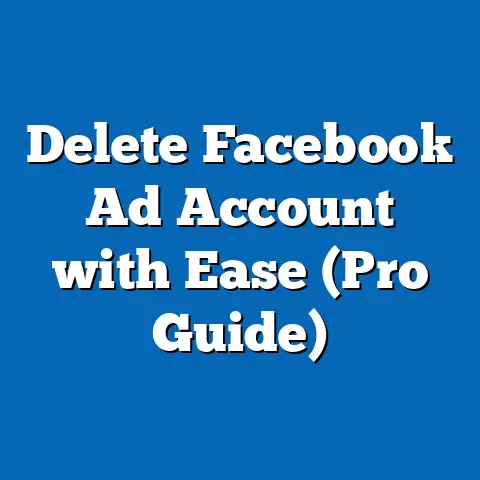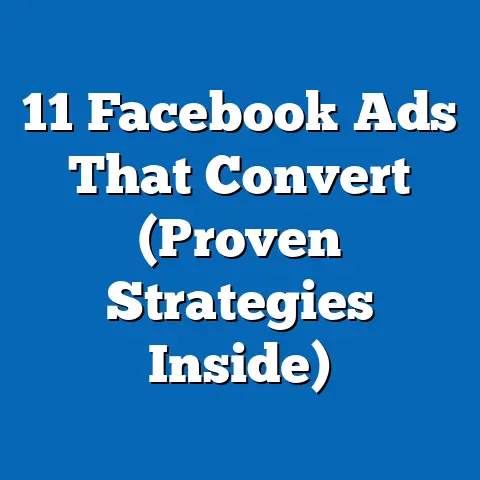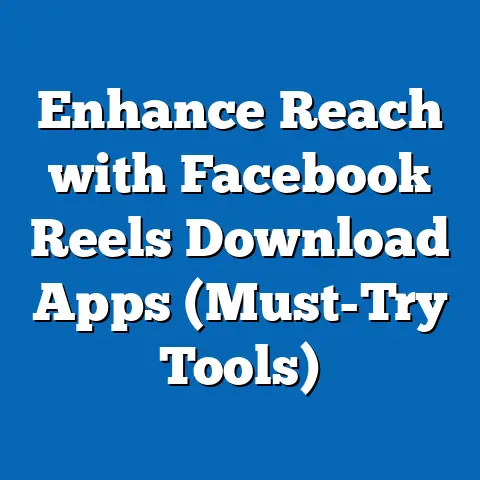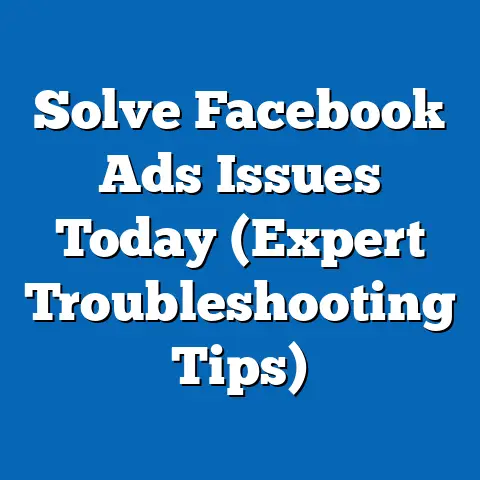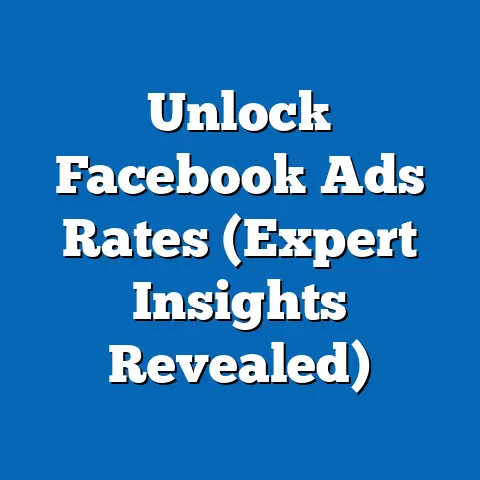Master Facebook Ads Scraping (Proven Strategies Revealed)
In today’s digital marketing landscape, where aesthetics and user experience reign supreme, understanding what makes a Facebook ad truly captivating is crucial. The visual appeal, the compelling copy, and the seamless user journey all contribute to an ad’s effectiveness. But how do we decipher the secrets behind successful ads? How do we uncover the strategies that resonate with audiences and drive conversions? The answer lies in data, and one powerful method for gathering that data is through Facebook ads scraping.
I’ve spent years navigating the ever-changing world of Facebook advertising, and I’ve seen firsthand how data-driven insights can transform campaigns. Scraping, when done ethically and strategically, allows us to analyze competitor strategies, identify market trends, and ultimately, elevate our own advertising efforts. This guide will walk you through the ins and outs of Facebook ads scraping, from understanding the basics to implementing proven strategies, ensuring you stay ahead in the competitive world of digital marketing.
Understanding Facebook Ads Scraping
What is Facebook Ads Scraping?
Facebook ads scraping is the process of extracting data from Facebook advertisements. Think of it as a digital reconnaissance mission where we gather publicly available information about ads to gain valuable insights. This data can include everything from the ad copy and visuals used, to the targeting parameters employed, and even estimated performance metrics.
In today’s data-driven environment, it’s not enough to simply create ads based on intuition. We need concrete evidence to support our decisions. Facebook ads scraping allows us to move beyond guesswork and make informed choices based on what’s actually working in the market.
Legal and Ethical Considerations
Before diving into the technical aspects of scraping, it’s crucial to address the legal and ethical considerations. Scraping data without regard for these boundaries can lead to serious consequences.
Here’s what you need to keep in mind:
- Terms of Service: Always review Facebook’s Terms of Service. Scraping practices that violate these terms can result in account suspension or legal action.
- Privacy: Respect user privacy. Only collect publicly available data. Avoid scraping personal information or data that requires authentication to access.
- Rate Limiting: Be mindful of the frequency of your requests. Overloading Facebook’s servers with excessive scraping can lead to your IP being blocked. Implement delays between requests to avoid this.
- Transparency: If you’re using scraped data for commercial purposes, be transparent about your methods. Disclose that you’re using publicly available data to analyze market trends or competitor strategies.
I’ve always believed in ethical data collection. It’s about gathering information to improve our understanding of the market, not about exploiting or infringing on anyone’s rights.
Types of Data You Can Extract
- Ad Copy: Analyze the language, tone, and messaging used in successful ads.
- Visuals: Identify the types of images and videos that resonate with audiences.
- Targeting Information: Understand the demographics, interests, and behaviors targeted by competitors.
- Call-to-Action (CTA): Determine the most effective CTAs for driving clicks and conversions.
- Engagement Metrics: Estimate the level of engagement (likes, comments, shares) an ad is receiving.
- Landing Pages: Analyze the landing pages associated with ads to understand the complete user journey.
Potential Benefits of Scraping Facebook Ads
Scraping Facebook ads can unlock a treasure trove of benefits for your advertising strategy:
- Competitor Analysis: Gain insights into your competitors’ ad strategies, including their messaging, targeting, and creative approaches.
- Market Trend Identification: Identify emerging trends in your industry and adapt your advertising accordingly.
- Ad Campaign Enhancement: Improve your own ad campaigns by learning from the successes (and failures) of others.
- Creative Inspiration: Discover new and innovative ad formats and creative ideas.
- Targeting Optimization: Refine your targeting parameters based on the audiences that are responding to similar ads.
- Cost Reduction: Optimize your ad spend by focusing on strategies that have proven to be effective.
Takeaway: Facebook ads scraping is a powerful tool for gathering data-driven insights that can transform your advertising strategy. However, it’s crucial to approach scraping ethically and responsibly, respecting Facebook’s terms of service and user privacy.
Tools and Techniques for Scraping Facebook Ads
Overview of Scraping Tools
There are numerous tools available for scraping Facebook ads, each with its own strengths and weaknesses. Here’s a breakdown of some popular options:
- Paid Scraping Tools:
- AdSpy: A comprehensive ad intelligence platform that allows you to search and analyze millions of ads from around the world. It offers advanced filtering options and detailed analytics.
- BigSpy: Another popular ad spy tool that provides access to a vast database of Facebook ads. It includes features like ad tracking, competitor analysis, and creative inspiration.
- PowerAdSpy: This tool focuses on providing actionable insights into competitor strategies. It offers features like lead generation, audience targeting, and creative analysis.
- Free Scraping Tools:
- Facebook Ad Library: Facebook’s own tool for searching and viewing ads. While it doesn’t offer automated scraping, it’s a valuable resource for manual data collection.
- Web Scraping Extensions: Browser extensions like Web Scraper and Data Miner can be used to extract data from web pages, including Facebook ads. However, these tools may require some technical expertise.
- AdSpy: A comprehensive ad intelligence platform that allows you to search and analyze millions of ads from around the world. It offers advanced filtering options and detailed analytics.
- BigSpy: Another popular ad spy tool that provides access to a vast database of Facebook ads. It includes features like ad tracking, competitor analysis, and creative inspiration.
- PowerAdSpy: This tool focuses on providing actionable insights into competitor strategies. It offers features like lead generation, audience targeting, and creative analysis.
- Facebook Ad Library: Facebook’s own tool for searching and viewing ads. While it doesn’t offer automated scraping, it’s a valuable resource for manual data collection.
- Web Scraping Extensions: Browser extensions like Web Scraper and Data Miner can be used to extract data from web pages, including Facebook ads. However, these tools may require some technical expertise.
When choosing a tool, consider your budget, technical skills, and the specific data you need to collect. Paid tools offer more advanced features and larger databases, while free tools can be a good starting point for basic scraping.
Programming Languages and Libraries
For those with programming skills, creating a custom scraping solution can provide greater flexibility and control over the data collection process. Python is a popular choice for web scraping due to its ease of use and extensive libraries.
Here are some key Python libraries for scraping Facebook ads:
- Beautiful Soup: A library for parsing HTML and XML documents. It’s used to extract data from web pages.
- Scrapy: A powerful web scraping framework that provides a complete solution for building and running scrapers.
- Selenium: A tool for automating web browsers. It can be used to interact with web pages and extract data from dynamic content.
- Requests: A library for making HTTP requests. It’s used to retrieve web pages from the internet.
Here’s a basic example of how to use Beautiful Soup to scrape data from a Facebook ad:
“`python import requests from bs4 import BeautifulSoup
url = “https://www.facebook.com/ads/library/?id=YOUR_AD_ID” response = requests.get(url) soup = BeautifulSoup(response.content, “html.parser”)
ad_copy = soup.find(“div”, class_=”ad-description”).text print(ad_copy) “`
Note: This is a simplified example. Scraping Facebook ads using Python requires a deeper understanding of HTML structure and Facebook’s dynamic content loading.
Facebook’s Ad Library
Facebook’s Ad Library is a valuable resource for gathering ad information. It allows you to search and view ads that are currently running on Facebook and Instagram.
Here’s how to use the Ad Library effectively:
- Access the Ad Library: Go to https://www.facebook.com/ads/library.
- Search for Ads: Enter keywords related to your industry, competitors, or target audience.
- Filter Results: Use the filters to narrow down your search by location, ad category, and platform.
- Analyze Ads: Review the ad copy, visuals, targeting information, and engagement metrics.
The Ad Library provides a legitimate and ethical way to gather data about Facebook ads. However, it doesn’t offer automated scraping capabilities, so you’ll need to manually collect the data you need.
The Role of APIs in Scraping
APIs (Application Programming Interfaces) can simplify the process of gathering data from Facebook ads. Facebook provides several APIs that allow developers to access ad data programmatically.
Here are some relevant Facebook APIs:
- Marketing API: Allows you to manage and optimize your Facebook ad campaigns. It provides access to ad performance data, targeting options, and creative tools.
- Graph API: A general-purpose API that allows you to access data from Facebook’s social graph. It can be used to retrieve information about users, pages, and events.
Using APIs requires technical expertise and adherence to Facebook’s API terms of service. However, it can provide a more efficient and reliable way to gather data compared to traditional web scraping.
Takeaway: There are various tools and techniques available for scraping Facebook ads, ranging from paid ad spy tools to free web scraping extensions and programming languages. Choose the option that best suits your budget, technical skills, and data collection needs. Don’t forget to leverage Facebook’s Ad Library as a legitimate source of ad information.
Proven Strategies for Effective Facebook Ads Scraping
Identifying Successful Ad Formats, Copy Styles, and Target Demographics
The key to effective Facebook ads scraping is knowing what to look for. Here are some strategies for identifying successful ad formats, copy styles, and target demographics:
- Analyze Ad Engagement: Focus on ads with high levels of engagement (likes, comments, shares). These ads are likely resonating with their target audience.
- Identify Recurring Themes: Look for recurring themes and patterns in successful ads. This could include specific keywords, visual styles, or messaging approaches.
- Examine Targeting Parameters: Pay attention to the demographics, interests, and behaviors targeted by successful ads. This can provide insights into the audiences that are most receptive to your message.
- Track Ad Performance Over Time: Monitor how ad performance changes over time. This can help you identify trends and adapt your strategies accordingly.
For example, I once noticed that video ads with short, attention-grabbing intros were consistently outperforming other ad formats in a particular niche. By analyzing the ad copy and targeting parameters of these successful video ads, I was able to create a similar campaign that generated a significant increase in conversions.
Case Studies of Successful Scraping
Real-world examples can provide valuable insights into how businesses have successfully utilized scraping to inform their advertising strategies.
Here’s a hypothetical case study:
Company: An e-commerce business selling organic skincare products.
Challenge: Struggling to generate leads and sales through Facebook ads.
Solution: The company used a combination of paid ad spy tools and manual scraping to analyze competitor ads. They identified that successful competitors were using video ads featuring customer testimonials and focusing on the benefits of organic ingredients.
Results: Based on these insights, the company created a series of video ads featuring customer testimonials and highlighting the benefits of their organic skincare products. They also refined their targeting parameters to focus on audiences interested in organic and natural products. As a result, they saw a 50% increase in leads and a 30% increase in sales.
Continuous Monitoring and Adaptation
The world of Facebook advertising is constantly evolving. Facebook’s algorithms, policies, and user preferences are always changing. That’s why it’s crucial to continuously monitor your ad performance and adapt your strategies accordingly.
Here are some tips for continuous monitoring and adaptation:
- Track Key Metrics: Monitor key metrics like click-through rate (CTR), conversion rate, cost per click (CPC), and return on ad spend (ROAS).
- A/B Test Your Ads: Experiment with different ad copy, visuals, and targeting parameters to see what works best.
- Stay Updated on Facebook’s Policies: Keep up-to-date with Facebook’s advertising policies and guidelines to avoid violations.
- Follow Industry Trends: Stay informed about the latest trends and best practices in Facebook advertising.
I’ve learned that the most successful advertisers are those who are willing to experiment, adapt, and continuously improve their strategies based on data-driven insights.
Takeaway: Effective Facebook ads scraping involves identifying successful ad formats, copy styles, and target demographics. Analyze ad engagement, identify recurring themes, and examine targeting parameters. Learn from real-world examples and continuously monitor your ad performance to adapt your strategies accordingly.
Analyzing and Interpreting Scraped Data
Key Performance Indicators (KPIs)
Analyzing the scraped data effectively requires focusing on the right key performance indicators (KPIs). Here are some important KPIs to consider:
- Click-Through Rate (CTR): The percentage of people who click on your ad after seeing it. A high CTR indicates that your ad is relevant and engaging.
- Conversion Rate: The percentage of people who take a desired action (e.g., make a purchase, sign up for a newsletter) after clicking on your ad. A high conversion rate indicates that your landing page is effective.
- Cost Per Click (CPC): The amount you pay each time someone clicks on your ad. A low CPC indicates that your ad is efficient.
- Return on Ad Spend (ROAS): The amount of revenue you generate for every dollar you spend on advertising. A high ROAS indicates that your ad campaign is profitable.
- Engagement Rate: The level of interaction (likes, comments, shares) your ad receives. A high engagement rate indicates that your ad is resonating with your target audience.
Data Visualization
Visualizing the data can help you identify trends and patterns more easily. Tools like Excel, Tableau, and Google Data Studio can be used to create charts and graphs that illustrate your data.
Here are some examples of data visualizations that can be useful for analyzing scraped data:
- Bar Charts: Compare the performance of different ad formats or copy styles.
- Line Graphs: Track ad performance over time.
- Pie Charts: Show the distribution of your target audience by demographics or interests.
- Heatmaps: Identify the most effective targeting parameters.
A/B Testing
A/B testing is a powerful technique for refining your ad strategies based on insights gained from scraping. It involves creating two versions of an ad (A and B) and testing them against each other to see which one performs better.
Here’s how to use A/B testing effectively:
- Identify a Variable: Choose a variable you want to test (e.g., ad copy, visual, CTA).
- Create Two Versions: Create two versions of your ad that are identical except for the variable you’re testing.
- Run the Test: Run the test for a sufficient period of time to gather statistically significant data.
- Analyze the Results: Analyze the results to see which version performed better.
- Implement the Winner: Implement the winning version of your ad.
By A/B testing your ads, you can continuously optimize your campaigns based on data-driven insights.
Takeaway: Analyzing and interpreting scraped data involves focusing on key performance indicators (KPIs), visualizing the data, and using A/B testing to refine your ad strategies.
Ethical Considerations and Future Trends in Facebook Ads Scraping
Responsible Data Usage
As we’ve discussed throughout this guide, ethical considerations are paramount when it comes to Facebook ads scraping. Responsible data usage involves respecting Facebook’s terms of service, protecting user privacy, and being transparent about your methods.
Here are some additional tips for responsible data usage:
- Obtain Consent: If you’re collecting data from users directly, obtain their consent before doing so.
- Anonymize Data: Anonymize data whenever possible to protect user privacy.
- Secure Data: Store data securely to prevent unauthorized access.
- Be Transparent: Be transparent about how you’re using the data and who you’re sharing it with.
I’ve always believed that data should be used for good. By using data responsibly, we can create more effective and ethical advertising campaigns.
Future Trends in Facebook Ads Scraping
The future of Facebook ads scraping is likely to be shaped by advancements in AI and machine learning. These technologies could make it easier to gather and analyze data from Facebook ads.
Here are some potential future trends:
- AI-Powered Scraping: AI could be used to automate the process of scraping Facebook ads, making it faster and more efficient.
- Machine Learning Analysis: Machine learning could be used to analyze scraped data and identify patterns and trends that would be difficult to detect manually.
- Personalized Advertising: AI and machine learning could be used to create more personalized advertising campaigns based on scraped data.
Upcoming Changes in Facebook’s Policies
Facebook’s policies are constantly evolving. It’s important to stay updated on these changes to ensure that your scraping practices remain compliant.
Here are some potential changes to watch out for:
- Increased Data Privacy Regulations: Governments around the world are increasingly focused on data privacy. This could lead to stricter regulations on how data is collected and used.
- Changes to Facebook’s API: Facebook may make changes to its API that affect how developers can access ad data.
- Crackdowns on Scraping: Facebook may take action against scrapers that violate its terms of service.
By staying informed about these changes, you can adapt your scraping practices accordingly and avoid potential penalties.
Takeaway: Ethical considerations are paramount when it comes to Facebook ads scraping. Use data responsibly, stay informed about future trends, and be prepared for upcoming changes in Facebook’s policies.
Conclusion
Facebook ads scraping is a powerful strategic tool that can provide marketers with invaluable insights into the competitive landscape, market trends, and the effectiveness of their own advertising efforts. By understanding the basics of scraping, implementing proven strategies, analyzing and interpreting scraped data, and adhering to ethical considerations, marketers can unlock the full potential of this technique.
As a digital marketing expert, I encourage you to embrace these proven strategies and stay ahead in the ever-evolving world of digital marketing. By mastering the art of scraping, you can enhance your understanding of the competitive landscape and refine your advertising strategies to achieve better results.

